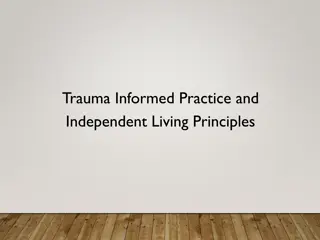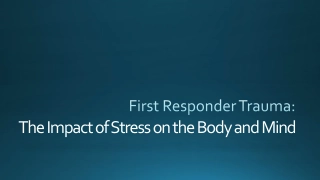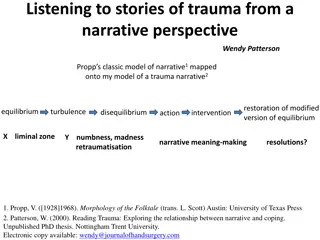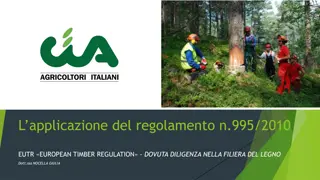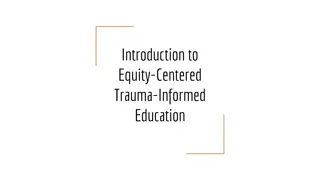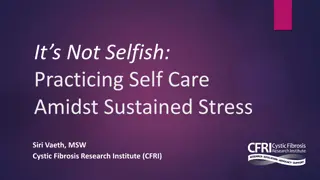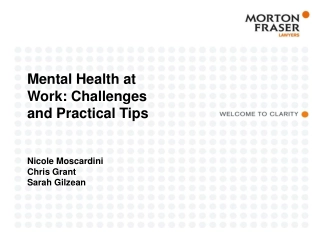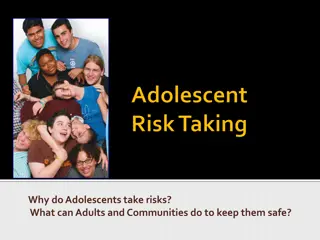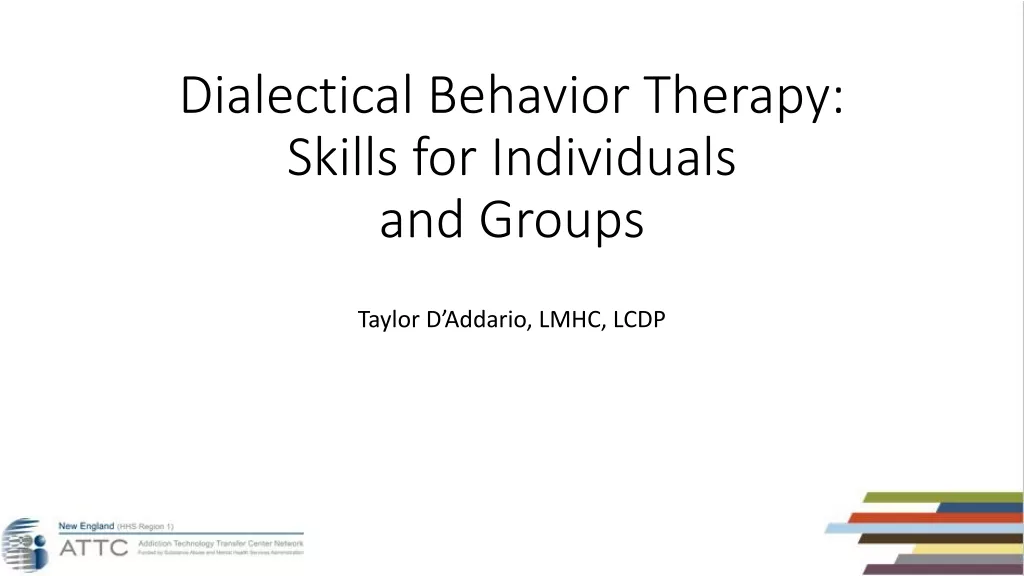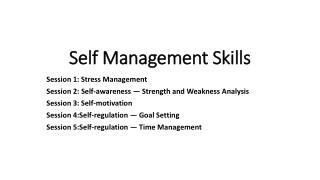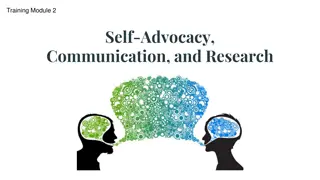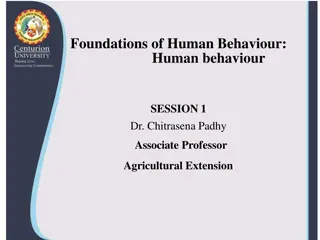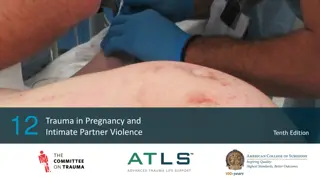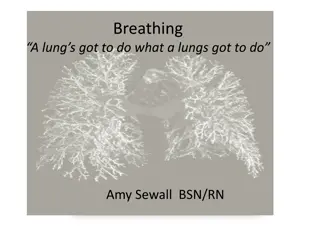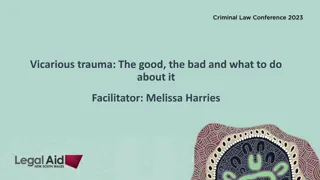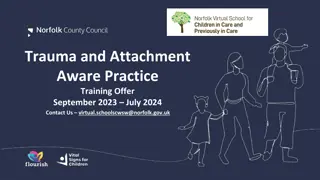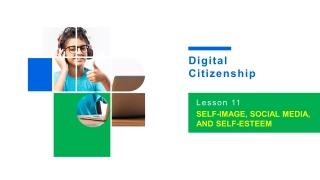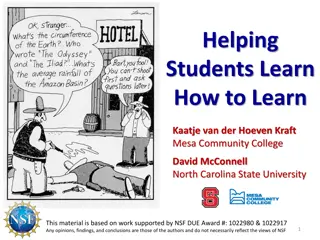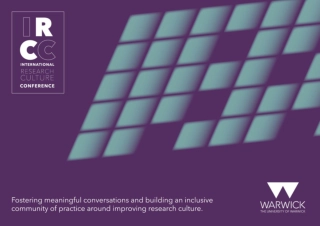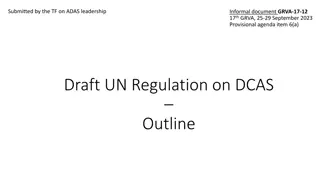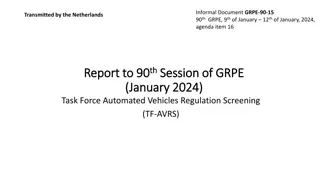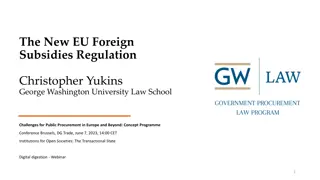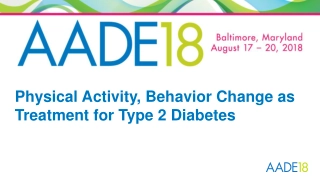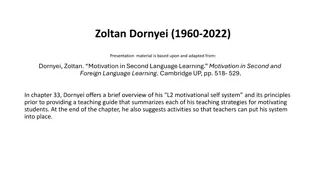Understanding Trauma, Stress, and Behavior: Insights from Research on Growing Up and Promoting Self-Regulation
Explore the impact of trauma, stress, and behavior on individuals through a contextual approach based on research findings. Learn about two types of individuals exhibiting antisocial behavior, the effects of social exclusion on brain function, and the influence of racial discrimination on brain microstructure and health outcomes. Discover the implications of Harlow's experiments with isolated infant monkeys. Stay informed on modern brain research and new studies shedding light on these complex issues.
Download Presentation
Please find below an Image/Link to download the presentation.
The content on the website is provided AS IS for your information and personal use only. It may not be sold, licensed, or shared on other websites without obtaining consent from the author. Download presentation by click this link. If you encounter any issues during the download, it is possible that the publisher has removed the file from their server.
Presentation Transcript
De krokodil, het paard en de ruiter een contextuele aanpak op basis van onderzoek Over opgroeien en het begrijpen van trauma, stress en gedrag. En over het bevorderen van motivatie en zelfregulatie iProf. Dr. GHP (Peer van der Helm, HL en UvA) Helm.vd.p@hsleiden.nl
Modern hersenonderzoek: Regelmatig bijdragen met vertaling van wetenschap naar praktijk op: https://www.socialevraagstukken.nl/author/peer-van-der-helm/ https://sociaalweb.nl/auteur/peer-van-der-helm/ https://www.hsleiden.nl/residentiele-jeugdzorg Of linked in: peer van der helm Of: https://blog.pedagogiek.nu/
Twee soorten daders met antisociaal gedrag: koud en berekenend op voordeel uit: oorzaak hersenbeschadiging warm en impulsief/dwangmatig , loopt op den duur niet goed af: oorzaak (vroegkinderlijk) trauma en negatieve jeugdervaringen
Antisociaal gedrag nieuw onderzoek: Chwaszcz J, Bartczuk RP, Niewiadomska I, S awska-Jaroszewska P (2022) Quality of life and prosocial or antisocial coping with resource deprivation: A cross-sectional study of people at risk of social exclusion. PLoS ONE 17(9): e0275234. https://doi.org/10.1371/journal. pone.027523 Sociale uitsluiting beschadigd het voorste gedeelte van de hersenen en bevordert antisociaal gedrag
A new study shows that the experience of racial discrimination affects the microstructure of the brain, as well as increasing the risk for health disorders. New findings on repeated microtrauma: racial discrimination damages the brain The authors hypothesize that the burden of trauma and racial discrimination may affect brain matter integrity through the stress system. The affected tracts are involved in emotional regulation and cognitive processes, which may in turn lead to behavioral changes, such as increased consumption of drugs or foods, that increase risk for health conditions. Onyebuchi Okeke, Aziz Elbasheir, Sierra Carter, Abigail Powers, Yara Mekawi, Charles F. Gillespie, Ann Schwartz, Bekh Bradley, Negar Fani. Indirect Effects of Racial Discrimination on Health Outcomes Through Prefrontal Cortical White Matter Integrity. Biological Psychiatry: Cognitive Neuroscience and Neuroimaging, 2022; DOI: 10.1016/j.bpsc.2022.05.004
Is dit nieuw? Harlows experimenten met pasgeboren aapjes uit 1965 gescheiden van hun moeder ontwikkelden antisociaal gedrag maar stopten ook met eten en drinken Harlow H. F., Dodsworth R. O., & Harlow M. K. (1965). Total social isolation in monkeys. Proceedings of the National Academy of Sciences of the United States of America. Retrieved from https://www.ncbi.nlm.nih.gov/pmc /articles/PMC285801/pdf/pnas001 59-0105.pdf Lees Noreena Herz (2020): De eenzame eeuw
Interventies? Cochrane Library 1. Howick 2022: maar 5% effectief 2. Van der Helm 2022: straf niet effectief voor recidivevermindering Wat dan wel? https://www.jclinepi.com/article/S0895-4356(22)00100-7/fulltext https://www.nature.com/articles/s41380-022-01661-0 Van der Helm, G.H.P (2022). Effective interventions in mental health and youthcare.
Katalin Somers 2022
Wat werkt en waarom? van der Helm, 2023 Sociaalweb: https://sociaalweb.nl/nieuws/zwaar-gedragsgestoord-verward- of-eenzaam-nieuw-hersenonderzoek-laat-zien-dat-we-beter- moeten-luisteren/ Minder dwang meer opleiding Psycho educatie Peer support Counseling Positief klimaat en huisvesting Kleine effecten traumatherapie EMDR, CBT, NET exposure
Stimuleren van zelfregulatie : Self Determination Theory (Ryan & Deci, 2018; Billen 2022) Verbondenheid Competentie Autonomie De belofte en hoop op herstel 11
Zelfregulatie: het kalmeren van de krokodil, door het versterken van de ruiter en het paard (de krokodit zit ondermeer in onze hersenen in de BNST, het primitieve alarmsysteem in onze hersenen). BNST: vechten, vluchten of verstijven of meedoen In plaatjes: Anxiety and Addiction. Neuropsychopharmacol 41, 126 141 (2016). https://doi.org/10.1038/npp.2015.185 Avery, S., Clauss, J. & Blackford, J. The Human BNST: Functional Role in
Relatie Therapeutisch klimaat Antisociaal Gedrag
Behoeften van het personeel (Van Miert 2022 in voorbereiding) Veiligheid Motivatie en betekenis Functioneren van het team Gedeelde visie en doelstellingen Transformationeel leiderschap Anders: Einat, 2021: prison changed me and I just work there en: Ellemers 2022: integriteitsparadox Einat, T., & Suliman, N. (2021). Prison Changed Me and I Just Work There: Personality Changes Among Prison Officers. The Prison Journal, 101(2), 166 186. https://doi.org/10.1177/0032885521991091 16
Psycho-educatie en voortdurende feedback noodzakelijk voor personeel: compassie is de sleutel En onze leraren en hulpverleners te instrueren om gedrag te begrijpen en een beter klimaat te scheppen in onze klassen voor speciaal onderwijs en (forensische) instellingen Help hen met hun eigen cognitieve en emotionele zelfregulering. Beheers onze eigen "morele vinger En bevrijd ze van giftige tegenoverdracht en morele stress: voorkom happen! 17
Het leefklimaat van locatie X: overall resultaat 5 3.473.61 Vorige meting (40) Huidige meting (30) Referentiegro ep (148) Ervaren leefklimaat: resultaten GCI-R 4 3.00 3 2 1 Totaal Leefklimaat 5 3.89 3.79 3.74 3.73 3.71 3.70 3.64 3.49 3.43 3.38 4 3.25 2.91 2.86 2.63 2.51 3 2 1 Hulp & Steun Leren & Zingeving Repressie Onderlinge omgang Leefomgeving Waardering leefklimaat: perceptie cli nten 1 2 3 4 5 1 = helemaal niet goed; 5 = heel goed Hulp van de begeleiding 3.41 1 = helemaal niet goed; 5 = heel goed 3.83 1 = helemaal niet goed; 5 = heel goed Omgang met elkaar 3.52 3.41 3.62 3.59 1 = heel saai; 5 = heel gezellig 1 = helemaal niet goed; 5 = heel goed De regels op de afdeling 1 = helemaal niet veilig; 5 = heel veilig Verdeling veiligheidsbelev ing 0.0 cli nten Waardering leefklimaat: perceptie medewerkers 2 5 0 2 4 6 8 10 8 15 Ondersteuning Wat je hier leert 7.5 6.5 Omgang cli nten onderling Hoe de afdeling eruitziet Regels op de afdeling Veiligheid op de afdeling 6.0 6.8 7.0 7.1 Helemaal niet veilig Niet veilig 18
Het werkklimaat 4 1 2 3 4 5 MATE WAARIN WERKGEVER Ontwikkelingsmogelijkheden MATE WAARIN WERKNEMER Extra taken Toekomstperspectief Passief leiderschap Inspirerend leiderschap Passief leiderschap Inspirerend leiderschap Positief team functioneren Steun team bij moeilijke situaties Tevredenheid OVERIG Weerstand tegen verandering Gedeelde visie Verbondenheid team Vorige meting (4) Huidige meting (4) Referentiegroep (356) 1 2 3 4 5 6 Vervulling Huidige meting 19
een veilige plek, verbondenheid, competentie en autonomie zorgen voor zelfregulatie en herstel Bedankt voor het luisteren First the connection than the correction! 20






